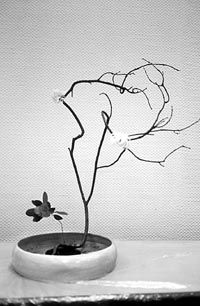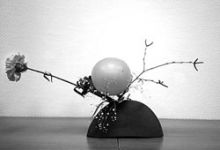Ikebana is an ancient Japanese art, literally meaning, “living flower.” The aggressive Japanese Samurai, being inspired with the idea of harmony five hundred years ago, figured out that the power is not only in fight but also in beauty. Since then they began to gradually transform their might into aesthetics and botany.
I’ve been introduced to this amazing art during the two lessons at the Japanese Center at the Kyiv Mohyla Academy. The ikebana courses were taught by two charming young ladies, Kyiv-based Tetiana Nadberezhna and Anzhela Lobastova from Moldova.
One may assume that in Ukraine ikebana is a female rather than male art. Besides this journalist, only a couple of men could be seen in the boundless female sea.
In her keynote speech, Anzhela explained the major principles of building the composition: symmetry — asymmetry, principal element — secondary element, rhythm — arrhythmia, and the balance principle. Such notions as line, mass, and plane are also of big importance. Major harmony laws lay a basement for creating an ikebana.
The first theme was, The Snow. But it wasn’t snowing yet at that time, and the theme didn’t inspire me in the least. In general, no matter what commission a person is given, he or she will come up with what he has at heart. And at that time my major worries were about love triangles.
Since I didn’t bring any floral material with me, I had to sink into petty racket. Tanya Nadberezhna kindly furnished me with a rather exotic plant. It looked like a crimson conic rush. I immediately recognized it as a lover. (I notify you in advance that I couldn’t remember the plants’ names: they were so lengthy that it would make this article too big. This is why I use names of my own coinage. Anyway, this is not about words but forms and matter).
Then I grabbed something reminding of a burdock leaf — a perfect embodiment of the feminine essence. Its middle part sort of clings to you and the top tends to run away. Nice small fluffy flowers symbolize women’s flippancy, reminding one of a lady making her hairdressing at the mirror in the morning. Tanya also gave me a couple of highly exotic purplish-blue stemless flowers which I named butterflies. They would stand for women’s romanticism. Now we put together the burdock (leave or stay), fluffy little flowers (flippancy), butterfly flowers (romanticism), and — voila! Here is a portrait of a lady.
Something like a husband or ex-boyfriend — a powerful stem with branches covered with thorns. It stands between the rush lover and his lady. Its thorns, on the one hand, offer the lady a protection, and on the other, threaten her.
A girl by name Masha granted me with a couple of reddish branches for the “lover,” depicting his arms stretched towards his beloved. All in all, we’ve got a spectacular love triangle pierced with tension. Reminds one of Anna Karenina or Carmen or Pedro Almodovar’s drama movies.
Masha has erected something directly opposite in terms of moods under the title of Happy Love.
The girls at the courses make great compositions; it’s just that they can’t explain what they mean by them. For me, with my male analytical mind, it’s a piece of cake. Thus, the group and I were mutually helpful.
The Happy Love ikebana has everything in couples: pink balls inside the net, rosy roses in the vase; but one of the paper leaves was obviously unnecessary. Masha was pondering over it for a long while. I suggested that she were more merciless. After removing the extra one it appeared that the remaining one also has a couple — the net.
I saw a very funny composition and made a question to its author, a young woman with short haircut, “Do you have children?” “Yes, my daughter is three,” she answered. “This is her,” I said pointing at her ikebana: a little orange balloon, a shaggy clove pink of the same color, and a variety of disheveled herbs. “What’s your daughter’s name?” I asked. “Can’t you guess?” she responded roguishly. “Well, that’s too much for me,” I had to give up. “Yuliya.” At that I understood that I could possibly figure it out by myself: the composition’s general view resembled a humming top (yula in Russian).
Next day we were all told to make something reflecting the New Year’s spirit.
The same amiable lady, mother of the three-year-old Yuliya, demonstrated me her new composition and asked another roguish question, “Now, what do you think this is?”
The ikebana presented two CDs placed on a vase and surrounded by a halo of flowers. “Your husband’s eyes,” was my answer. “They’ll follow you through the New Year’s celebrations, day and night.”
“This is an owl,” she said in a childish offended voice. “Who would argue this,” I said. “At daytime he dozes in front of the TV set, and at nights...” “Stop it!” she said laughing.
This time Masha made a composition titled, Happy Love at Home, meaning a holiday for two with your lover. Again, there were two roses, this time red as blood. In other words, their love is fresh as a fresh-killed meat. Next to them stands some sort of a wicker fence with two golden leaves on it. When I made a photo of this ikebana it occurred to me that together they make a heart shape. “Could you explain this?” Masha pointed at a leaf wrapping up the roses. “This is a desire to protect one’s love.” “That’s logical,” she observed dryly. “And who is Him?” I asked, unable to suppress my curiosity. “My husband, friend, and brother,” the girl declared proudly.
I had at my disposal the ruins of my first ikebana plus a miraculous plant in a shape of a bird. An idea of the Phoenix composition came to me at once.
Phoenix is a symbol of renovation, rising from the ashes with its strong arched wings.
But I had only one wing, a.k.a. yesterday’s burdock. I had to counterbalance it with something coniferous: a typical ikebana decision based on an aesthetical paradox. Anzhela put two yellow flowers in the vase to shield Phoenix’s neck. I liked them, too: they could serve as pads for this mythical bird. As regards the master’s corrections for Masha’s Happy Love at Home, they changed the composition’s psychological essence dramatically. Anzhela parted the golden leaves on the wicker fence. The result was, of course, interesting and beautiful in its own way. But now it became rather beautiful parting than beautiful love.
The nature of things is hard to deceive. One can’t conceal one’s psychological condition or nature. Usually you arrange the flowers according to the energetic pattern inside you. Women cannot explain what exactly they are doing because they lack male logic, but they create life itself, while men are more into allegories. Let me give you an example.
A student named Yuliya did not bring any material with her, as well as myself. She managed to find somewhere a branchy piece of black wood resembling haloxylon. I advised her to decorate it with scarlet tinsel symbolizing the Tempter. I was overwhelmed with Biblical theme. Yulia tried various ways to place the tinsel, but somehow she wasn’t satisfied with it. She removed the Serpent and started to try some white flowers on the tree. “Oh, women’s stuff again,” I thought in disappointment and left to the other room to make pictures of the already complete ikebana. When I came back, Yulia wasn’t there anymore. But her production really astounded me. Her haloxylon blossomed in the middle of a desert! A cozy-looking pink rose gracefully settled itself in its shadow. Even the harshest samurai would probably start to cry at the sight of them.
Some have a Phoenix as a New Year’s ikebana, others — their husbands or children, still others — happy love. And Tetiana Nadberezhna, who taught at this courses, has built a luxurious three-master. A ship heading to the future!
Some people’s works looked a little incomplete but still had an aura of joyful emotions around them. For instance, a peroxide blonde with curls made something beyond imagination: a pile of fir branches, tulips, and tinsel. However, this mess radiated such hospitality that it was obvious the author is a kindhearted and amiable person. Whoever comes to visit her on New Year’s eve will not go away hungry or sad. The same I wish to you, dear readers!








